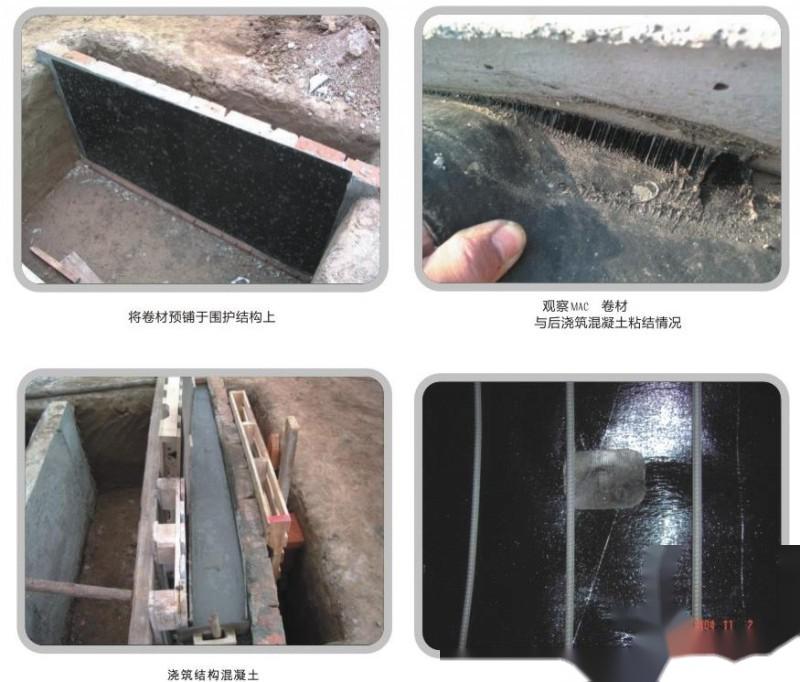I. Product Introduction
BAC wet-laid composite double-sided self-adhesive rubber asphalt waterproofing membrane is made of SBS and other synthetic rubber, tackifiers, and road petroleum asphalt as the base material, with a strong high-density polyethylene film ( HDPE) or aluminum foil as the top surface material (or no film), and a removable silicone-coated isolation film or silicone-coated isolation paper as the bottom surface anti-adhesive isolation material. This product is a non-reinforced self-adhesive waterproofing membrane (hereinafter referred to as non-reinforced self-adhesive membrane). The product complies with JC8401999 "Self-adhesive Rubber Asphalt Waterproofing Membrane" national industry standard.
II. Variety and Specifications
L, varieties are classified according to the top surface material into three types: polyethylene film ( PE), aluminum foil ( AL), and no film ( N).
According to the usage function, they are divided into exposed waterproofing projects ( O), non-exposed waterproofing projects ( I), and auxiliary waterproofing projects.
Specifications Table 1: Specification Thickness ( mm) Width ( mm) Area ( m2) 1.2 1000 20 1.5 20 2.0 15
III. Product Features
1, self-adhesive: adheres to the substrate, providing safety and environmental protection;
2, excellent low moisture flexibility, large elongation, and strong adaptability to substrate expansion or cracking deformation;
3, self-healing: has the ability to heal minor cracks caused by nail penetration or stress;
4, durable adhesive sealing, with seams adhering and lasting as long as the membrane itself;
5, composed of self-adhesive rubber asphalt and HDPE (or aluminum foil), providing excellent water resistance.
IV. Scope of Application
BAC wet-laid composite double-sided self-adhesive rubber asphalt waterproofing membrane with a polyethylene film surface is suitable for non-exposed roofs or underground projects as a waterproof layer (including open-cut subways);
it is also suitable for waterproofing layers in projects like ponds, channels, etc., especially for projects where open flames are not allowed.
The membrane with an aluminum foil surface is suitable for various exposed roof waterproofing layers.
Double-sided self-adhesive membranes are only used for auxiliary waterproofing and can also be used for bonding and sealing at the junction of two incompatible waterproof layers.
V. Key Points of System Design
The waterproof system of non-reinforced self-adhesive membranes consists of a waterproof substrate, primer, functional waterproof layer, detail auxiliary waterproof layer, terminations, and seam sealing group, with the protective isolation layer set according to design requirements.
For system waterproofing materials, non-exposed areas use polyethylene film ( PE) on the surface, and exposed roofs use aluminum foil ( AL) as the covering; additional and auxiliary areas use PE film surface or no film (double-sided self-adhesive).
For system matching materials, the primer uses substrate treatment agents, sealant, modified asphalt coatings (with details doing composite additional waterproofing), fixing pressure strips, and screws, etc. When used in a single layer, the thickness should not be less than 2mm; for two or more layers of protection, the thickness of each layer of the membrane should not be less than 1.5mm. Membranes with a thickness of 1.2mm and no film are only used for auxiliary waterproofing.
VI. Packaging, Storage, and Transportation
Packaging—rolled packaging with plastic straps or in cardboard boxes.
Storage and Transportation—avoid exposure to sun and rain, and ensure ventilation. Storage temperature should not exceed 50°C, stored upright, not exceeding two layers. If packaged in cardboard boxes, do not stack more than five layers.













